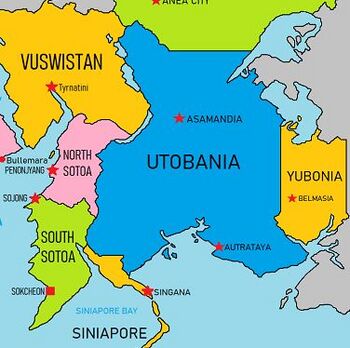Utobania: Difference between revisions
No edit summary |
No edit summary |
||
| Line 10: | Line 10: | ||
|alt_map = | |alt_map = | ||
|map_caption = | |map_caption = | ||
|capital = *[[Asamandia]] | |capital = *[[Asamandia]] (legislative) | ||
*[[Autrataya]] (administrative) | *[[Autrataya]] (administrative) | ||
|official_languages = | |official_languages = | ||
| Line 91: | Line 91: | ||
}} | }} | ||
The '''Republic of Utobania''', most commonly known as '''Utobania''', is a nation | The '''Republic of Utobania''', most commonly known as '''Utobania''', is a nation located on the continent of [[Nortua]], bordered by [[Panbell]], [[Sopita]], [[New Anea]], [[Besmenia]], [[Yubonia]] and [[Vuswistan]], with coastlines along the [[Kuskok Sea]] to the south and the [[Nortua Sea]] to the southwest. The federal republic consists of thirteen states and three federal territories. [[Asamandia]] is the national capital and largest city while [[Autrataya]] is the seat of the federal government. With a population of over 46.8 million, Utobania is the [[List of sovereign states and dependent territories (Iearth)|3rd-most populous country]] on Nortua. Utobania has two capitals, with [[Autrataya]] being the administrative capital and [[Asamandia]] being the legislative capital. | ||
Utobania has its origins in the Utobania kingdoms which, from the 18th century, became subject to the [[Constantio|Constantio Empire]], along with the [[Siniapore]] Straits Settlements protectorate and the Sotoas. Mainland continental Utobania was unified as the Utobanian Union in 1939. In 1963, Utobania combined with | Utobania has its origins in the Utobania kingdoms which, from the 18th century, became subject to the [[Constantio|Constantio Empire]], along with the [[Siniapore]] Straits Settlements protectorate and the Sotoas. Mainland continental Utobania was unified as the Utobanian Union in 1939. In 1963, Utobania combined with Sopita, [[New Anea]], and [[Yubonia]] and formed the United Federation of Utobania. In 1965, Sopita was expelled from the federation, followed by the independence of New Anea in 1978 after a separatist referendum and Yubonia in 1993 in a similar fashion. | ||
The country is multi-ethnic and multi-cultural, which has a significant effect on its politics. About half the population is ethnically Utobanian, with large minorities of Siniaporeans, Sotoans, and indigenous peoples. The country's official language is [[wikipedia:greek language|Utobanian]], while [[wikipedia:english language|Caticeze-English]] remains an active second language. While recognising [[wikipedia:Christianity|Christianity]] as the country's established religion, the constitution grants freedom of religion to non-Christians, with the country being composed with | The country is multi-ethnic and multi-cultural, which has a significant effect on its politics. About half the population is ethnically Utobanian, with large minorities of Siniaporeans, Sotoans, and indigenous peoples. The country's official language is [[wikipedia:greek language|Utobanian]], while [[wikipedia:english language|Caticeze-English]] remains an active second language. While recognising [[wikipedia:Christianity|Christianity]] as the country's established religion, the constitution grants freedom of religion to non-Christians, with the country being composed with sizable populations of minority religions, such as the largest concentration of [[wikipedia:Islam|Muslims]] in Nortua (19% of Utobania's population). Utobania is considered a middle power and is a member state of several international organizations such as the [[Coalition of Crown Albatross]] and the [[Sotoan Basin Union]]. The current [[Chancellor of Utobania]] is [[Kennedy Telgado]]. | ||
==History== | ==History== | ||
Revision as of 19:23, 10 September 2023
Republic of Utobania | |
|---|---|
|
Flag | |
 | |
| Capital | |
| Government | |
| Kennedy Telgado | |
| Kaitlin Belmana | |
| Population | |
• 2020 estimate | 46,839,000 |
| Currency | mark |
| Date format | mm-dd-yyyy |
The Republic of Utobania, most commonly known as Utobania, is a nation located on the continent of Nortua, bordered by Panbell, Sopita, New Anea, Besmenia, Yubonia and Vuswistan, with coastlines along the Kuskok Sea to the south and the Nortua Sea to the southwest. The federal republic consists of thirteen states and three federal territories. Asamandia is the national capital and largest city while Autrataya is the seat of the federal government. With a population of over 46.8 million, Utobania is the 3rd-most populous country on Nortua. Utobania has two capitals, with Autrataya being the administrative capital and Asamandia being the legislative capital.
Utobania has its origins in the Utobania kingdoms which, from the 18th century, became subject to the Constantio Empire, along with the Siniapore Straits Settlements protectorate and the Sotoas. Mainland continental Utobania was unified as the Utobanian Union in 1939. In 1963, Utobania combined with Sopita, New Anea, and Yubonia and formed the United Federation of Utobania. In 1965, Sopita was expelled from the federation, followed by the independence of New Anea in 1978 after a separatist referendum and Yubonia in 1993 in a similar fashion.
The country is multi-ethnic and multi-cultural, which has a significant effect on its politics. About half the population is ethnically Utobanian, with large minorities of Siniaporeans, Sotoans, and indigenous peoples. The country's official language is Utobanian, while Caticeze-English remains an active second language. While recognising Christianity as the country's established religion, the constitution grants freedom of religion to non-Christians, with the country being composed with sizable populations of minority religions, such as the largest concentration of Muslims in Nortua (19% of Utobania's population). Utobania is considered a middle power and is a member state of several international organizations such as the Coalition of Crown Albatross and the Sotoan Basin Union. The current Chancellor of Utobania is Kennedy Telgado.

